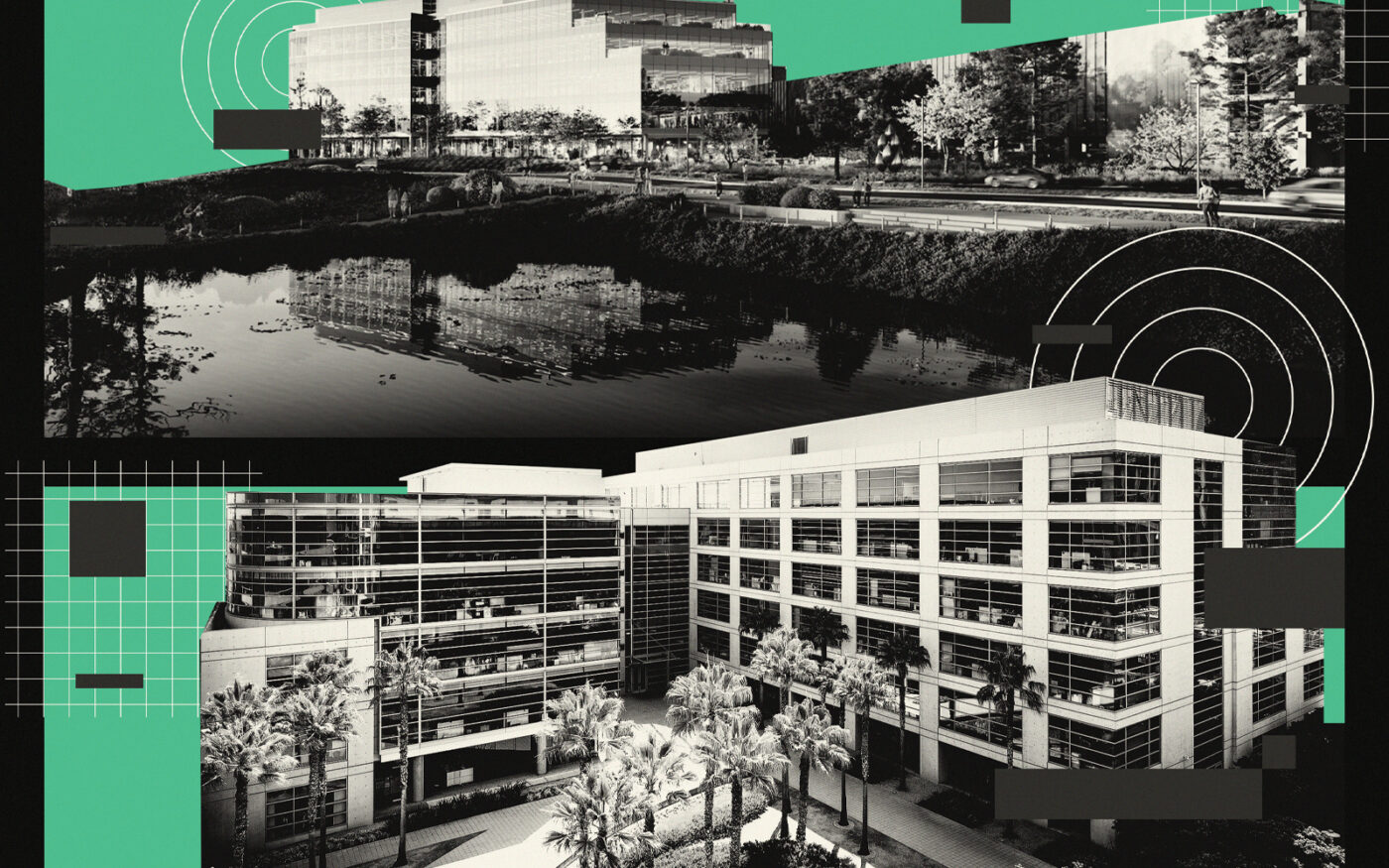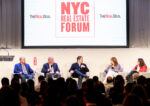In Bay Area office, developers bet on AI
Billions in investor funding shifts from life sciences to AI, as office developers try to follow the money

The lab vacancy rate was below 1% in San Francisco’s Mission Bay neighborhood in April 2022 when DivcoWest paid over $1,100 a square foot to buy Old Navy’s 320,000-square-foot former headquarters at 550 Terry Francois along the city’s eastern waterfront. The office, blocks from the University of California San Francisco and Kaiser Permanente campuses, was set to become life-sciences space via a $30 million-plus conversion, according to city permits.
A few years later, many venture capital funders who were attracted to the Covid-era promise of life sciences have moved onto greener pastures — also known as AI — leaving ground-up developers and owners of newly converted spaces in the lurch.
Divco has already upgraded the building with the “mechanical, power and infrastructure on par with the latest building deliveries.” It’s also upgraded such amenities as a new lobby, conference and training rooms and outdoor collaboration space, according to a rep from CBRE, which is marketing the building. But it’s held off on a full lab conversion and is now pitching the building to both life-science and tech tenants.
The wait-and-see approach may pay off. The empty property made headlines in April when a very high profile new tenant, which already has two buildings leased around the corner, was rumored to be interested: OpenAI.
So it goes in a market driven by big money chasing the next big innovation while commercial owners try to keep up. Not every developer has the deep pockets and patience Divco does, and it’s unclear if the move from lab space to AI office space even makes sense for many owners, especially if they’ve already shelled out cash to specialize their buildings with the ultra-expensive upgrades that labs require and that most AI companies are unlikely to need.
“I don’t think a lot of landlords are in a position to pivot back from life science to AI,” said William O’Daly, senior associate at Avison Young. “The smaller players that don’t have the ability to extend or renegotiate their financing terms are going to lose their buildings.”
A Covid boom
The Bay Area has long been the second-biggest market for life-sciences companies, after Boston. Both have top-tier universities and medical centers.
When Covid-19 hit, investor interest in everything from treatments to testing kits led to a surge in life-sciences funding. Funding for Bay Area life-sciences companies jumped from $8.9 billion in 2019 to more than $15 billion in 2020, according to Savills data. Funding peaked at $20 billion in 2021.
This thrust the sector “into the limelight,” said Savills research manager Brianna Friedman, “elevating company valuations and attracting a wave of new investors spurred by the heightened supply and demand dynamics.”
Office owners took note for two reasons: Lab space vacancy was below 5% Bay Area-wide, and life-sciences workers were among the only groups not working remotely, since they needed to be near their incubators and industrial freezers. They paid “a pretty hefty price” to get into or expand their presence in the market, even for second- or third-generation lab space, according to Colliers life-sciences agent Kyle Hipple. He estimates that on top of $1,000-plus per square foot to buy these properties at the peak, new owners needed to put in $400 to $500 per square foot for the typical conversion.
“[Going fully remote forever was]one of the tech industry’s worst mistakes in a long time.”
“Landlords were banking on paying that top dollar, but hopefully in return getting top-dollar lab rents,” he said.
There was so much funding and so little inventory that life-sciences companies were signing on for more space than they actually needed, adding to the frenzy. Life-sciences companies tend to cluster, Hipple explained, one reason why developers began building mega-campuses for them.
“They are always either collaborating or stealing each other’s employees,” he said.
Building life-sciences spaces has always been a risky bet, O’Daly said, not only because they’re more expensive to develop than traditional office, but also because research and development requires a huge amount of upfront investment, and the drug or treatment may be a bust.
Until last year, there were so many companies forming and expanding that it seemed as though someone would always want new or refurbished lab space, Hipple said.
“Even if a company goes under, there’s going to be another company right behind it to take over,” he said.
Enter AI
Soon after the peak, the “landscape shifted” amid rising interest rates and macroeconomic uncertainties, Friedman said. In 2022, venture funding for Bay Area life-sciences companies dropped to $16.8 billion, according to Savills figures, and in 2023, that funding dwindled further, to $10.9 billion.
Investors “realized they were spending a little bit too freely and taking moonshots” on mostly Covid-related research, Hipple said.
Then, just as interest was waning for life-sciences companies, venture capitalists found a new darling: artificial intelligence.
Funding for Bay Area AI companies surged to $10.6 billion for the 15 months from early 2023 through March of this year, according to Avison Young, just over half the total amount raised for all AI companies in the U.S. during that time. In response, San Francisco and Silicon Valley became the most active markets in the country for AI leasing by volume, each with more than 2 million square feet leased, according to CBRE.
One key factor: AI companies may be just as likely as life-sciences companies to require in-office work.
OpenAI CEO Sam Altman declared the “experiment” of remote work “over” at an event in San Francisco last spring. Going fully remote forever, he added, was “one of the tech industry’s worst mistakes in a long time.”
“It’s hard to predict the VCs and where they’re going to redirect their attention. A lot of people will just try to ride
the hot hand.”
A few months later, the maker of ChatGPT signed the city’s biggest lease since 2018, taking half a million square feet at Uber’s Mission Bay headquarters.
Others followed suit, and now 90% of AI companies are not remote, according to Cody Kollmann, an agent at Lee & Associates. Some even have a mandate from their venture capital backers to prioritize in-office work.
Kollman recently repped a deal with Replit AI, a code generator for software engineers, which was looking to go from 5,000 square feet in San Francisco to nearly 50,000 square feet on the Peninsula in just 15 months. He took them to see “dozens” of options. One was a development in San Carlos where the owner was entitled for a lab space conversion but ultimately decided against it given the 8 million square feet of brand new life-sciences space already underway and expected to be completed by 2026.
“There will be significant life-sciences oversupply for years to come,” said Tim Hogan, a principal at Avison Young. “Much of the coming new product will surpass any conversion.”
The question now is whether those life-sciences developments might also interest AI companies. Some do have a hardware component that requires research and development space, but most AI companies are looking for the same types of offices as traditional office users, and they don’t need to pay for the high floor loads, ventilation and power put into life-sciences spaces.
“Most life-sciences developers and owners would be hesitant to remove laboratory improvements, but for a large enough AI or office tenant, it may be possible,” said Colin Yasukochi, executive director of CBRE’s Tech Insights Center. Regular office buildings are probably more cost-effective, he added.
Wait and VC
If AI can’t fill the planned life-sciences space, O’Daly expects the Peninsula to be most impacted by the drop in demand, since it has the most inventory. The East Bay, especially such areas as Berkeley and Emeryville near life-sciences incubators like the University of California Berkeley’s Bakar Labs and the Lawrence Berkeley National Lab, is tighter because it’s less expensive and has less supply and a higher density of life-sciences companies, he said.
Trammell Crow and CBRE Investment Management broke ground last summer on 234,000 square feet of lab and office space on the Peninsula at its 200 Twin Dolphin Drive development after paying $65 million in early 2022 for the five-acre Redwood City plot.
Leasing on the Peninsula last year was “slow across the board for both office and life sciences due to economic headwinds, reduced funding and a slowdown in FDA approvals,” Mike Moran, vice chairman at CBRE, said. But momentum is picking up in 2024. He didn’t report any signed leases in the development, which is about a year away from completion, but he said that CBRE is “already addressing several larger tenants who are looking for headquarter opportunities.”
He wouldn’t name specific concessions available for leases in the development.
Two years ago, when there were five companies applying for every open lab space, landlords were giving between $175 and $225 per square foot in tenant improvement allowances for long-term leases, Hipple said. Today, there’s about 8 million existing square feet available between San Francisco, San Mateo, Santa Clara and Alameda counties out of about 43 million square feet in inventory, and some developers have now agreed to a full spec delivery so there’s no immediate out-of-pocket improvement cost to the tenant. Free rent is also up. In the boom, tenants got three months free on a 10-year lease. Now, landlords offer up to a year of free rent on a seven-year lease, he said.
There could be a light at the end of the tunnel for life-sciences owners who can wait it out, agents and analysts agreed. Because of the Bay Area’s proximity to universities, incubators and venture capital funders, there are always new life-sciences companies forming in the region.
Plus, big pharma companies are also buying up promising startups at an increased rate because they need to refill their R&D pipelines as their exclusivity licenses on existing drugs expire.
“Fundamentally, we’re so sound for a robust life science market that it’ll come back,” said O’Daly. “It’s just going to take time and new drugs and new technology to be successful and we’re in a position to do that.”
Office operators who went all in on life-sciences and can wait for a recovery will do so, and those who can’t, “need to figure out an exit strategy,” he said.
As to whether funders will turn away from AI as quickly as they moved on from life sciences if something new and shiny comes on the scene, commercial owners and developers can only guess.
“It’s hard to predict the VCs and where they’re going to redirect their attention,” Hipple said. “But I think in a world where there’s always new technology, a lot of people will just try to ride the hot hand and, if you make a good bet, it’ll compensate you more than well enough in the long run.”




